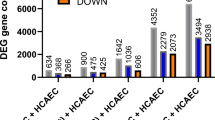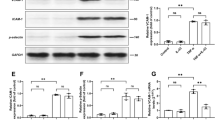Abstract
Immune cells and inflammatory mediators play important roles in the development of atherosclerotic vascular inflammation. IL-27 is a member of the IL-6/IL-12 family that can promote Th1 responses and augment the release of inflammatory mediators from human mast cells and monocytes. However, the direct effect of IL-27 on human coronary artery endothelial cells was unclear. In this study, the effects of IL-27 and TNF-α on the cell surface expression of adhesion molecules, inflammatory cytokines, and chemokines were investigated. Results showed that IL-27 alone could significantly promote the release of chemokine CXCL10. However, IL-27 could further significantly enhance the TNF-α-mediated upregulation of adhesion molecules ICAM-1 and VCAM-1, inflammatory cytokine IL-6, as well as chemokines CCL5 and CXCL10 from human coronary artery endothelial cells. The release of IL-6, CCL5, and CXCL10 were significantly suppressed by specific signaling molecule inhibitors, implying that the induction of these mediators from the human coronary artery endothelial cells could be differentially regulated by the c-Jun N-terminal kinase, p38 mitogen-activated protein kinase, and nuclear factor-κB pathways. These results provided new insights into the effect of IL-27 on the TNF-α mediated activation of human coronary artery endothelial cells in atherosclerotic vascular inflammation.







Similar content being viewed by others
References
Ross R (1999) Atherosclerosis—an inflammatory disease. N Engl J Med 340:115–126
Ait-Oufella H, Taleb S, Mallat Z, Tedgui A (2011) Recent advances on the role of cytokines in atherosclerosis. Arterioscler Thromb Vasc Biol 31:969–979
Hauer AD, Uyttenhove C, de Vos P, Stroobant V, Renauld JC, van Berkel TJ, van Snick J, Kuiper J (2005) Blockade of interleukin-12 function by protein vaccination attenuates atherosclerosis. Circulation 112:1054–1062
Smith E, Prasad KM, Butcher M, Dobrian A, Kolls JK, Ley K, Galkina E (2010) Blockade of interleukin-17A results in reduced atherosclerosis in apolipoprotein E-deficient mice. Circulation 121:1746–1755
Yla-Herttuala S, Lipton BA, Rosenfeld ME, Sarkioja T, Yoshimura T, Leonard EJ, Witztum JL, Steinberg D (1991) Expression of monocyte chemoattractant protein 1 in macrophage-rich areas of human and rabbit atherosclerotic lesions. Proc Natl Acad Sci USA 88:5252–5256
Szlosarek P, Charles KA, Balkwill FR (2006) Tumour necrosis factor-alpha as a tumour promoter. Eur J Cancer 42:745–750
Boesten LS, Zadelaar AS, van Nieuwkoop A, Gijbels MJ, de Winther MP, Havekes LM, van Vlijmen BJ (2005) Tumor necrosis factor-alpha promotes atherosclerotic lesion progression in APOE*3-Leiden transgenic mice. Cardiovasc Res 66:179–185
Kleemann R, Zadelaar S, Kooistra T (2008) Cytokines and atherosclerosis: a comprehensive review of studies in mice. Cardiovasc Res 79:360–376
Ridker PM, Rifai N, Pfeffer M, Sacks F, Lepage S, Braunwald E (2000) Elevation of tumor necrosis factor-alpha and increased risk of recurrent coronary events after myocardial infarction. Circulation 101:2149–2153
Ohta H, Wada H, Niwa T, Kirii H, Iwamoto N, Fujii H, Saito K, Sekikawa K, Seishima M (2005) Disruption of tumor necrosis factor-alpha gene diminishes the development of atherosclerosis in ApoE-deficient mice. Atherosclerosis 180:11–17
Yoshida H, Miyazaki Y (2008) Regulation of immune responses by interleukin-27. Immunol Rev 226:234–247
Bosmann M, Ward PA (2013) Modulation of inflammation by interleukin-27. J Leukoc Biol 94:1159–1165
Hunter CA, Kastelein R (2012) Interleukin-27: balancing protective and pathological immunity. Immunity 37:960–969
Hu S, Wong CK, Lam CW (2011) Activation of eosinophils by IL-12 family cytokine IL-27: implications of the pleiotropic roles of IL-27 in allergic responses. Immunobiology 216:54–65
Stumhofer JS, Hunter CA (2008) Advances in understanding the anti-inflammatory properties of IL-27. Immunol Lett 117:123–130
Kempe S, Heinz P, Kokai E, Devergne O, Marx N, Wirth T (2009) Epstein-barr virus-induced gene-3 is expressed in human atheroma plaques. Am J Pathol 175:440–447
Jin W, Zhao Y, Yan W, Cao L, Zhang W, Wang M, Zhang T, Fu Q, Li Z (2012) Elevated circulating interleukin-27 in patients with coronary artery disease is associated with dendritic cells, oxidized low-density lipoprotein, and severity of coronary artery stenosis. Mediators Inflamm 2012:506283
Hayden MS, Ghosh S (2004) Signaling to NF-kappaB. Genes Dev 18:2195–2224
Takeda A, Hamano S, Yamanaka A, Hanada T, Ishibashi T, Mak TW, Yoshimura A, Yoshida H (2003) Cutting edge: role of IL-27/WSX-1 signaling for induction of T-bet through activation of STAT1 during initial Th1 commitment. J Immunol 170:4886–4890
Mehra VC, Ramgolam VS, Bender JR (2005) Cytokines and cardiovascular disease. J Leukoc Biol 78:805–818
Blankenberg S, Barbaux S, Tiret L (2003) Adhesion molecules and atherosclerosis. Atherosclerosis 170:191–203
Cybulsky MI, Iiyama K, Li H, Zhu S, Chen M, Iiyama M, Davis V, Gutierrez-Ramos JC, Connelly PW, Milstone DS (2001) A major role for VCAM-1, but not ICAM-1, in early atherosclerosis. J Clin Invest 107:1255–1262
Li H, Cybulsky MI, Gimbrone MA Jr, Libby P (1993) An atherogenic diet rapidly induces VCAM-1, a cytokine-regulatable mononuclear leukocyte adhesion molecule, in rabbit aortic endothelium. Arterioscler Thromb 13:197–204
Wong CK, da Chen P, Tam LS, Li EK, Yin YB, Lam CW (2010) Effects of inflammatory cytokine IL-27 on the activation of fibroblast-like synoviocytes in rheumatoid arthritis. Arthritis Res Ther 12:R129
Taub DD, Lloyd AR, Conlon K, Wang JM, Ortaldo JR, Harada A, Matsushima K, Kelvin DJ, Oppenheim JJ (1993) Recombinant human interferon-inducible protein 10 is a chemoattractant for human monocytes and T lymphocytes and promotes T cell adhesion to endothelial cells. J Exp Med 177:1809–1814
Kawamura A, Miura S, Fujino M, Nishikawa H, Matsuo Y, Tanigawa H, Tomita S, Tsuchiya Y, Matsuo K, Saku K (2003) CXCR3 chemokine receptor-plasma IP10 interaction in patients with coronary artery disease. Circ J 67:851–854
Heller EA, Liu E, Tager AM, Yuan Q, Lin AY, Ahluwalia N, Jones K, Koehn SL, Lok VM, Aikawa E, Moore KJ, Luster AD, Gerszten RE (2006) Chemokine CXCL10 promotes atherogenesis by modulating the local balance of effector and regulatory T cells. Circulation 113:2301–2312
Takeda N, Manabe I, Shindo T, Iwata H, Iimuro S, Kagechika H, Shudo K, Nagai R (2006) Synthetic retinoid Am 80 reduces scavenger receptor expression and atherosclerosis in mice by inhibiting IL-6. Arterioscler Thromb Vasc Biol 26:1177–1183
Veillard NR, Kwak B, Pelli G, Mulhaupt F, James RW, Proudfoot AE, Mach F (2004) Antagonism of RANTES receptors reduces atherosclerotic plaque formation in mice. Circ Res 94:253–261
von Luettichau I, Nelson PJ, Pattison JM, van de Rijn M, Huie P, Warnke R, Wiedermann CJ, Stahl RA, Sibley RK, Krensky AM (1996) RANTES chemokine expression in diseased and normal human tissues. Cytokine 8:89–98
von Hundelshausen P, Weber KS, Huo Y, Proudfoot AE, Nelson PJ, Ley K, Weber C (2001) RANTES deposition by platelets triggers monocyte arrest on inflamed and atherosclerotic endothelium. Circulation 103:1772–1777
Harvey EJ, Ramji DP (2005) Interferon-gamma and atherosclerosis: pro- or anti-atherogenic? Cardiovasc Res 67:11–20
Whitman SC, Ravisankar P, Elam H, Daugherty A (2000) Exogenous interferon-gamma enhances atherosclerosis in apolipoprotein E-/- mice. Am J Pathol 157:1819–1824
Cao J, Wong CK, Yin Y, Lam CW (2010) Activation of human bronchial epithelial cells by inflammatory cytokines IL-27 and TNF-alpha: implications for immunopathophysiology of airway inflammation. J Cell Physiol 223:788–797
Acknowledgments
This study was supported by the National Natural Science Foundation of China (Project No. 81401309).
Author information
Authors and Affiliations
Corresponding author
Ethics declarations
Conflict of interest
The authors declare that they have no conflict of interest in the research.
Rights and permissions
About this article
Cite this article
Qiu, HN., Liu, B., Liu, W. et al. Interleukin-27 enhances TNF-α-mediated activation of human coronary artery endothelial cells. Mol Cell Biochem 411, 1–10 (2016). https://doi.org/10.1007/s11010-015-2563-3
Received:
Accepted:
Published:
Issue Date:
DOI: https://doi.org/10.1007/s11010-015-2563-3




